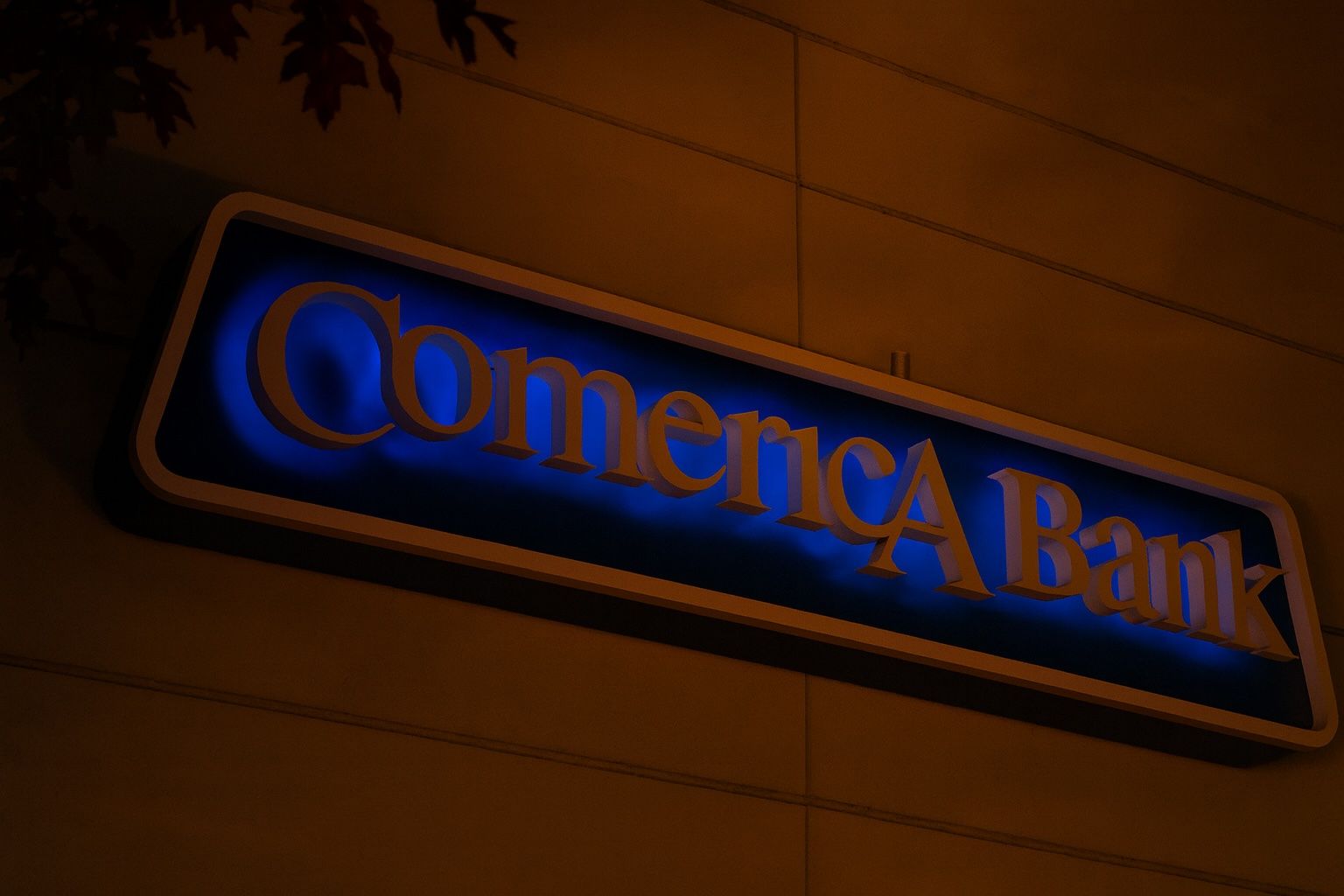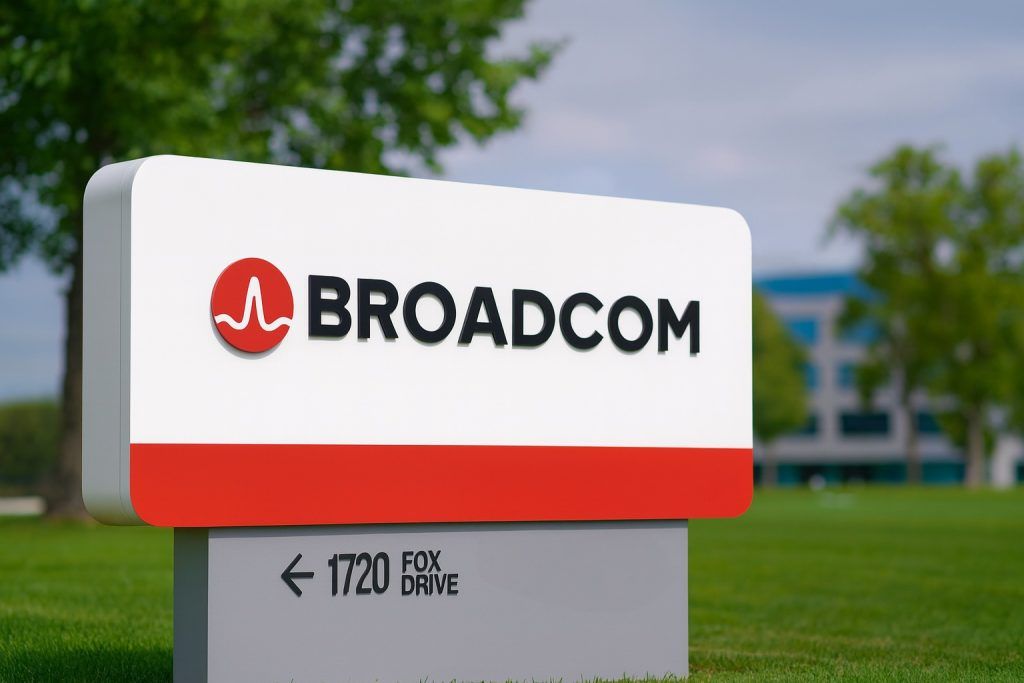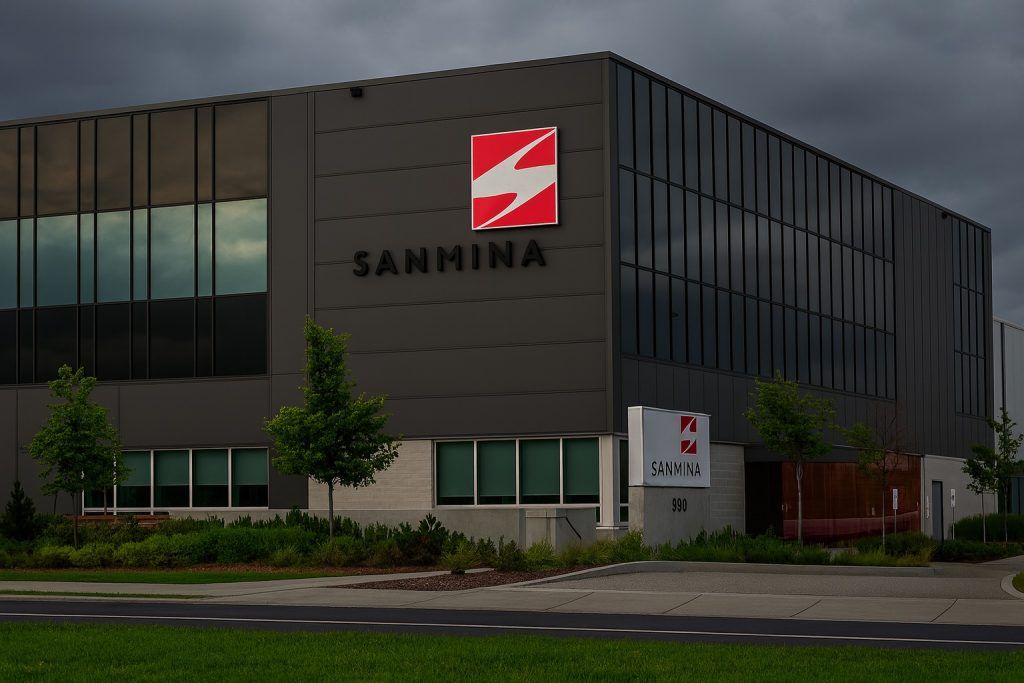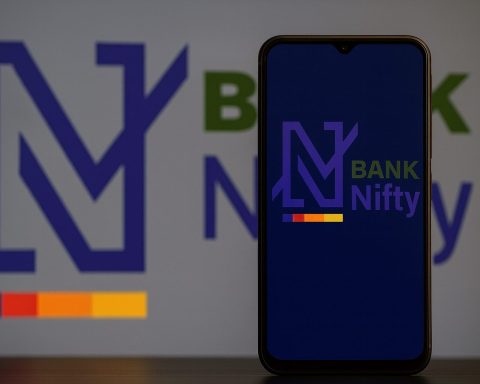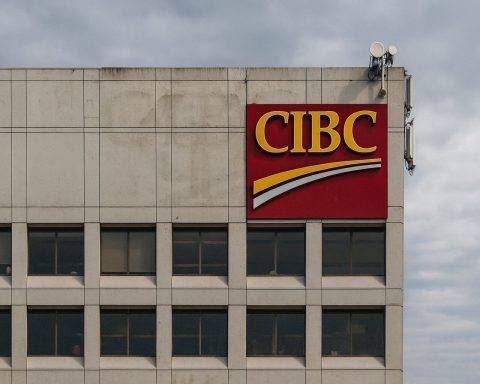- Stock Surge: On 6 October 2025, Comerica’s shares surged about 14–15 % to roughly $80–$81 per share after Fifth Third Bancorp announced an all‑stock deal to acquire Comerica [1] [2].
- Mega‑Deal: Fifth Third agreed to buy Comerica for $10.9 billion, issuing 1.8663 Fifth Third shares for each Comerica share – a 20 % premium to Comerica’s 10‑day volume‑weighted average price [3] [4].
- Combined Bank: The deal would create the ninth‑largest U.S. bank with $288 billion in assets and operations in 17 of the 20 fastest‑growing markets [5]. Fifth Third shareholders will own about 73 % of the combined company [6].
- Corporate Shifts: Comerica recently promoted Kristina Janssens to Chief Risk Officer and launched community initiatives supporting women‑owned small businesses and partnerships with the Detroit Lions and food charities [7].
- Analyst Views: Morgan Stanley raised its price target on Comerica to $76, Citigroup to $61, and Keefe Bruyette & Woods to $73; the consensus target is around $67 [8] [9]. Analysts see the Fifth Third merger as boosting scale but warn about integration and cost synergies [10].
- Regulatory Tailwinds: U.S. regulators under the Trump administration have streamlined bank‑merger approvals, reversing stricter Biden‑era rules [11]. Experts note a “more permissive environment” spurring banks to pursue deals sooner [12].
- Macro Conditions: Investors expect interest‑rate cuts later in 2025; Comerica Wealth Management’s Eric Teal notes that markets need lower inflation readings and slower growth to justify lower rates [13]. Debate continues as some Fed officials push for deeper rate cuts while others warn about inflation and policy uncertainty [14].
Current Stock Performance & Market Reaction
The announcement of Fifth Third Bancorp’s planned acquisition of Comerica sent CMA stock soaring. On 6 October 2025, Comerica’s investor‑relations website showed the stock opening near $81.00 and trading around $79.62–$80.56, up 9–14 % from the previous close [15]. MarketWatch reported that CMA shares rallied 15.1 % to $81.20, a three‑year high, while Fifth Third’s shares dipped 0.3 % [16]. The initial spike reflected the generous 20 % premium offered by Fifth Third and expectations that the combined bank would command more market share.
Investors also reacted to a brighter regulatory outlook. Reuters noted that U.S. regulators have streamlined bank‑merger reviews, reversing Biden‑era policies that imposed closer scrutiny. Acting Comptroller of the Currency Rodney Hood said the new rules reduce uncertainty and align with the Trump administration’s efforts to spur economic growth [17]. In another Reuters report, banking lawyer James Stevens observed that regulators’ moves “opened the doors” to larger deals, prompting banks to pursue mergers “sooner than later” [18]. The prospect of easier approvals and the race for scale boosted broader regional‑bank stocks; the KBW Nasdaq Bank Index edged higher while the SPDR S&P Regional Banking ETF gained about 1 % pre‑market [19].
Major Developments and Corporate News
Fifth Third–Comerica Merger
On 6 October 2025, Fifth Third Bancorp announced it would acquire Comerica in an all‑stock transaction worth $10.9 billion. Each Comerica share will convert to 1.8663 shares of Fifth Third, valuing CMA at $82.88 per share and implying a 20 % premium to its 10‑day volume‑weighted price [20]. The combined bank will hold $288 billion in assets, ranking ninth nationally, and operate in 17 of the 20 fastest‑growing U.S. markets [21].
Fifth Third CEO Tim Spence hailed Comerica as a “crown‑jewel middle‑market banking franchise” and said the merger accelerates Fifth Third’s strategy of building density in high‑growth markets and deepening commercial capabilities [22] [23]. He highlighted plans to build 150 branches in Texas, positioning the combined bank among the top five in Dallas, Houston and Austin [24]. Comerica CEO Curt Farmer said joining Fifth Third would allow Comerica to build on its commercial franchise and better serve clients [25].
Analysts generally viewed the tie‑up as strategically sound but raised concerns about integration and expense synergies. Truist analyst Brian Foran questioned whether Fifth Third can achieve the promised cost savings [26]. Baird analysts said the deal accelerates Fifth Third’s expansion into high‑growth markets and will improve growth in Comerica’s legacy regions [27]. Banking Dive noted that the deal was the largest U.S. bank merger announced in 2025 and that activist investor HoldCo Asset Management had previously pressured Comerica to sell [28].
Other Corporate Updates
Before the merger announcement, Comerica undertook several strategic initiatives:
- Risk Management: The bank promoted Kristina Janssens to senior executive vice president and chief risk officer. StocksToTrade highlighted this move as strengthening risk oversight [29].
- Philanthropy and Community Partnerships: Comerica launched a $150,000 funding initiative to support women‑owned small businesses and announced partnerships with the Detroit Lions and Kids’ Food Basket to address youth hunger [30]. These programs were part of Comerica’s efforts to bolster its community image and ESG credentials.
- Direct Express Contract: Banking Dive reported that Fifth Third will become the issuing bank for the Direct Express government debit‑card program, a contract previously held by Comerica [31]. Losing this contract removed a significant fee business for Comerica and likely increased pressure to find a strategic partner.
Analyst Forecasts & Price Targets
Following the merger announcement, analysts revised their forecasts for Comerica:
- Morgan Stanley raised its price target from $61 to $76 while maintaining an underweight rating; the average brokerage target price stood at $68.63 with a high estimate of $75 and a low of $56 [32]. Morgan Stanley cautioned that Comerica’s options implied high volatility and flagged potential downside risks [33].
- Citigroup increased its target price to $61, and Keefe Bruyette & Woods boosted theirs to $73 with an outperform rating [34]. A MarketBeat survey of analysts after the merger showed an overall hold rating with a consensus target of $67.05 [35].
- Nasdaq’s Fintel data (as of September 13 2025) indicated an average one‑year price target of $69.64, implying only about 0.93 % upside from the then‑current price, with a range of $56.56–$78.75 [36]. This suggests that many analysts believed Comerica was already fairly valued prior to the merger premium.
Earnings & Financial Metrics
StocksToTrade provided a snapshot of Comerica’s financials ahead of the merger: earnings per share (EPS) of $1.42, revenue of $3.24 billion, revenue per share of $25.24, a price‑to‑earnings ratio of 13.52, and pre‑tax profit margin around 24.1 % [37]. The bank held $1.24 billion in cash, total assets of $77.88 billion, and long‑term debt of $5.76 billion [38]. These metrics underscore Comerica’s mid‑cap status and solid profitability, but they also highlight limited scale compared with national peers.
Commentary & Expert Perspectives
Analysts and experts offered nuanced views on the merger and the banking sector:
- James Stevens, a law partner advising banks, said regulators have created “a more permissive environment” for mergers and that streamlined deal approvals have opened doors for banks to consider larger transactions [39]. He noted that banks are now moving quickly to strike deals before the regulatory climate potentially shifts again [40].
- Tom Michaud, CEO of investment bank Keefe Bruyette & Woods, remarked that regional lenders stand the best chance of obtaining approval and that there is a clear case for gaining scale. He urged banks to act sooner rather than later under the friendly regulatory regime [41].
- Michael Ashley Schulman of Running Point Capital told Banking Dive that the Fifth Third‑Comerica transaction could be the first domino in a new wave of consolidation as banks seek to “rack ’em and stack ’em” [42]. He and other analysts anticipate more mid‑size bank mergers given the regulatory tailwinds.
- Eric Teal, chief investment officer at Comerica Wealth Management, told TS2.tech that markets need lower inflation and slower growth to justify anticipated Fed rate cuts [43]. This highlights how macroeconomic data will influence banking profits and valuations.
- In a Reuters macro report, J.P. Morgan economist Michael Feroli critiqued Fed Governor Stephen Miran’s call for aggressive rate cuts, saying some arguments were questionable and cautioning that deep cuts could stoke inflation and market volatility [44]. The debate underscores uncertainty around future monetary policy.
Macroeconomic & Sector Context
Regional banks like Comerica operate in an environment shaped by interest‑rate expectations, regulatory changes and competition for scale.
Interest‑Rate Outlook and Economy
The Federal Reserve cut rates modestly in 2025, and markets anticipated further cuts later in the year. Eric Teal noted that investors want to see lower inflation readings and slower growth before pricing in deeper cuts [45]. Fed Governor Stephen Miran argued that Trump administration policies could drive the neutral rate near zero and advocated for half‑point cuts, but analysts like Michael Feroli cautioned that such moves carry inflation risks [46]. For banks, lower rates can squeeze net interest margins but also reduce funding costs and support loan demand.
Regulatory Environment
The merger climate has shifted dramatically. The Office of the Comptroller of the Currency reestablished a streamlined process for reviewing bank mergers, reversing a policy adopted under President Biden that mandated closer scrutiny for deals involving banks with over $50 billion in assets [47]. Acting Comptroller Rodney Hood said the changes reduce burdens and support an effective, non‑excessive framework [48]. Reuters noted that this move aligns with the Trump administration’s broader deregulatory agenda and encourages banks to pursue mergers to compete with larger peers [49].
Analysts believe regional banks are best positioned to take advantage of the relaxed rules. Tom Michaud observed that regional lenders should move quickly because the current administration offers the best chance of getting large deals approved [50]. The impetus to gain scale is evident in the factbox of U.S. regional bank mergers compiled by Reuters, which lists numerous transactions announced in 2025—including Fifth Third–Comerica—and attributes the surge to expectations of a lighter regulatory approach [51].
Competitive Landscape and Sector Health
Regional banks are racing to achieve scale to compete against national giants and fintech players. Fifth Third’s acquisition of Comerica will push the combined bank into the top tier, with major presence across the Midwest, Texas, California and Florida. Banking Dive noted that Fifth Third’s strategy includes launching 200 new branches by 2028 and using heat mapping to target growth markets [52]. The combined institution will operate in the Sun Belt and West Coast, providing diversification beyond Comerica’s core markets.
Other regional banks are also active. Reuters reported that banks such as PNC Financial, Synovus, Pinnacle and U.S. Bancorp have announced deals in 2025, highlighting a trend of consolidation among mid‑size lenders [53]. Regulatory tailwinds and the need to expand fee‑based businesses (e.g., wealth management, payments) are driving the trend. However, large global banks may face more scrutiny, and analysts say this environment offers the best opportunity for regional players to merge [54].
Conclusion
As of 6 October 2025, Comerica stands at the center of one of the year’s biggest banking stories. Fifth Third’s $10.9 billion all‑stock acquisition instantly boosted CMA’s share price and promised to create the ninth‑largest U.S. bank. The deal reflects a broader shift toward consolidation in regional banking, fueled by deregulatory policies and the quest for scale. Analysts are cautiously optimistic: they praise the strategic logic of combining complementary footprints but warn about integration challenges and limited upside after the merger premium. Macro‑economic uncertainty—particularly regarding interest‑rate paths and inflation—adds another layer of complexity. Yet with regulators easing merger reviews and mid‑size banks seeking partners, Comerica’s story may herald a new wave of regional bank consolidation in the United States.
In summary, Comerica’s stock surged roughly 14–15 % on October 6, 2025, after Fifth Third Bancorp agreed to acquire the bank in a $10.9 billion all-stock deal. The transaction offers a 20 % premium to Comerica shareholders, will create the ninth-largest U.S. bank with $288 billion in assets, and grants Fifth Third shareholders about 73 % ownership [55]. Investor optimism was fueled not only by these generous terms but also by a deregulation-friendly environment under the Trump administration that has streamlined bank-merger approvals [56].
The report notes that analysts generally view the merger as strategically sound, raising price targets to the $70–$76 range, but they caution about integration risks and limited upside after the premium [57]. Additional corporate updates include Comerica’s promotion of Kristina Janssens to Chief Risk Officer and new community partnerships [58]. Broader macroeconomic factors, such as expectations for future Fed rate cuts and uncertainty surrounding inflation, also influence outlooks, with experts like Eric Teal stressing the need for lower inflation and slower growth before deeper cuts are justified [59]. Overall, the merger exemplifies a wider consolidation trend among regional banks aiming to scale up in a favorable regulatory climate, suggesting that more such deals may be on the horizon [60].
References
1. investor.comerica.com, 2. www.morningstar.com, 3. www.53.com, 4. www.bankingdive.com, 5. www.53.com, 6. www.53.com, 7. stockstotrade.com, 8. www.ainvest.com, 9. www.marketbeat.com, 10. www.morningstar.com, 11. www.reuters.com, 12. www.reuters.com, 13. ts2.tech, 14. www.reuters.com, 15. investor.comerica.com, 16. www.morningstar.com, 17. www.reuters.com, 18. www.reuters.com, 19. www.cnbc.com, 20. www.53.com, 21. www.53.com, 22. www.reuters.com, 23. www.morningstar.com, 24. www.cnbc.com, 25. www.53.com, 26. www.morningstar.com, 27. www.reuters.com, 28. www.bankingdive.com, 29. stockstotrade.com, 30. stockstotrade.com, 31. www.bankingdive.com, 32. www.ainvest.com, 33. www.ainvest.com, 34. www.marketbeat.com, 35. www.marketbeat.com, 36. www.nasdaq.com, 37. stockstotrade.com, 38. stockstotrade.com, 39. www.reuters.com, 40. www.reuters.com, 41. www.reuters.com, 42. www.bankingdive.com, 43. ts2.tech, 44. www.reuters.com, 45. ts2.tech, 46. www.reuters.com, 47. www.reuters.com, 48. www.reuters.com, 49. www.reuters.com, 50. www.reuters.com, 51. sundayguardianlive.com, 52. www.bankingdive.com, 53. sundayguardianlive.com, 54. www.reuters.com, 55. www.53.com, 56. www.reuters.com, 57. www.ainvest.com, 58. stockstotrade.com, 59. ts2.tech, 60. www.reuters.com
